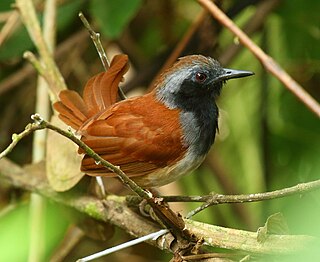
The white-bellied antbird, is a passerine bird which breeds in the tropical New World from Panama to northern Brazil and in Trinidad. It is also called Swainson's antcatcher after William John Swainson, who first described it scientifically. The genus is monotypic.

The chestnut-backed antbird is a passerine bird in subfamily Thamnophilinae of family Thamnophilidae, the "typical antbirds". It is found in Colombia, Costa Rica, Ecuador, Honduras, Nicaragua, and Panama.

The pearly antshrike is a species of bird in subfamily Thamnophilinae of family Thamnophilidae, the "typical antbirds". It is found in Brazil, Colombia, Ecuador, Peru, and Venezuela.

The northern chestnut-tailed antbird, or Zimmer's antbird, is a species of bird in subfamily Thamnophilinae of family Thamnophilidae, the "typical antbirds". It is found in Colombia, Ecuador, and Peru.

The Yapacana antbird is a species of passerine bird in subfamily Thamnophilinae of family Thamnophilidae, the "typical antbirds". It is found Brazil, Colombia, and Venezuela.

The sooty antbird is a species of bird in the family Thamnophilidae. It is found in Bolivia, Brazil, Colombia, Ecuador, and Peru. Its natural habitat is subtropical or tropical moist lowland forests.

The grey-headed antbird is a Vulnerable species of bird in subfamily Thamnophilinae of family Thamnophilidae, the "typical antbirds". It is found in Ecuador and Peru.
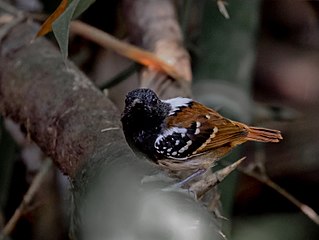
The southern chestnut-tailed antbird, or chestnut-tailed antbird, is a species of passerine bird in subfamily Thamnophilinae of family Thamnophilidae, the "typical antbirds". It is found in Bolivia, Brazil, and Peru.

The blue-lored antbird is a species of antbird in the family Thamnophilidae. It is found at low levels in humid Andean forests in western and northern Colombia, western Venezuela. It formerly included the Zeledon's antbird as a subspecies. The blue-lored antbird feeds on insects, and regularly follows swarms of army ants in order to catch prey flushed by the swarms, but it is not an obligate ant-follower like some species of antbirds. The blue-lored antbird is strongly sexually dichromatic: the male has an entirely black plumage, while the female has a rufous-brown plumage and a black mask. Both sexes have a blue patch of skin around the eyes.
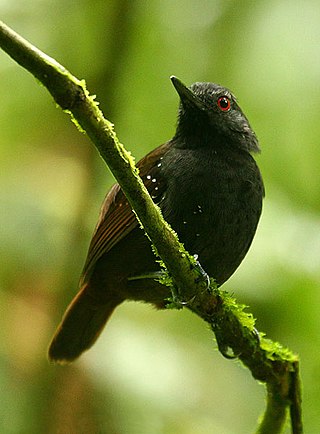
The dull-mantled antbird is a perching bird species in the antbird family (Thamnophilidae).

The white-shouldered antbird is a species of bird in the family Thamnophilidae. It is found in Brazil, Colombia, Ecuador, and Peru. Its natural habitat is subtropical or tropical swamps.

The Esmeraldas antbird is a species of bird in subfamily Thamnophilinae of family Thamnophilidae, the "typical antbirds". It is found in Colombia and Ecuador.

The grey-bellied antbird is a species of passerine bird in subfamily Thamnophilinae of family Thamnophilidae, the "typical antbirds". It is found Brazil, Colombia, and Venezuela.
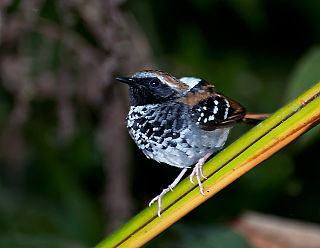
The squamate antbird is a species of bird in subfamily Thamnophilinae of family Thamnophilidae, the "typical antbirds". It is endemic to Brazil.
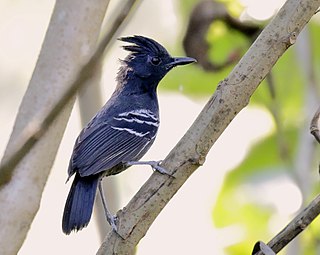
The white-lined antbird is a species of bird in the family Thamnophilidae. It is found in Bolivia, Brazil, and Peru. Its natural habitats are subtropical or tropical moist lowland forests and heavily degraded former forest.

The ocellated antbird is a species of antbird in subfamily Thamnophilinae of family Thamnophilidae, the "typical antbirds". It is found in Colombia, Costa Rica, Ecuador, Honduras, Nicaragua, and Panama.
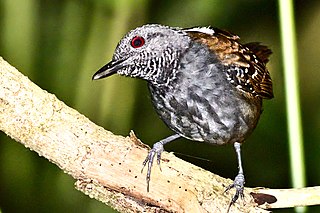
The Magdalena antbird is a species of bird in the family Thamnophilidae. It is found in Colombia and Venezuela. Its natural habitats are subtropical or tropical moist lowland forests and subtropical or tropical moist montane forests.
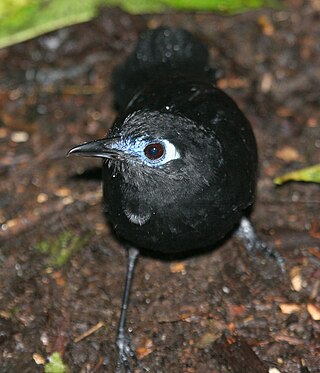
Zeledon's antbird is a species of antbird in the family Thamnophilidae. It is found at low levels in humid forests from Nicaragua to Panama, and in the Chocó of western Colombia and western Ecuador. Zeledon's antbird feeds on insects, and regularly follows swarms of army ants in order to catch prey flushed by the swarms, but it is not an obligate ant-follower like some species of antbirds.
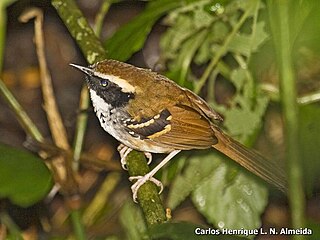
Myrmoderus is a genus of passerine birds in the family Thamnophilidae.

Sipia is a genus of passerine birds in the family Thamnophilidae.






















